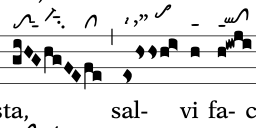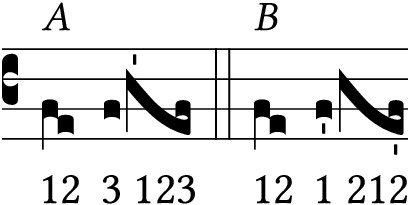Repercussions (Solesmes Method) in Vidi aquam
-
My practice has been to have my choirs rearticulate the third repeated note in the words aqua and salvi, but I've noticed that the modern notation edition of the Liber and the Bragers accompaniment write both of these with all three notes tied together. Of course, many people sing them that way, others repercuss every note, and it's unlikely to get an entire congregation to sing them in a unified fashion, but these editions appear to contradict what is stated in the front of the Liber. On p. xxviii of the Rules for Interpretation, there is an example essentially identical to the figure at aqua, which the commentary explains "is not a Pressus preceded by a punctum, but a Distropha followed by a Clivis." It continues: "As regards this last example it should be remembered that a repercussion (of fresh layer of the voice) is required each time a note affected by the ictus is of the same degree as the one immediately preceding it." Carroll (1956) explains the rule unambiguously: "In order to make a distinction, without possible error, between the pressus and the repercussion, remember that when in a given passage one finds a number of notes at the unison, UNLESS THE GROUP OF THESE NOTES TOGETHER TAKES THE FORM OF A TRISTROPHA [all caps in source], the passage contains at least one, and possibly several repercussions." The tripled note at salvi does not take the form of a true tristropha, i.e. three puncta, but rather distropha plus pes, which calls for a repercussion. Other accompaniment editors don't tie the three notes together in either instance. Does this represent a later development in the Solesmes method (similar to the counting revision before ictic notes at full bar lines), or is it merely an inconsistency? Is there a good argument in favor of singing the tripled notes without any repercussion?
-
Others will have better (and more complete) answers, but my one thought is that repercussions may work best in a live acoustic with at least a few seconds of reverb. I once suggested strongly that we do the repercussions in a set of propers in imitation of a well-regarded schola I had heard, and I'm afraid we sounded like we had a vocal problem, as the acoustic was very dry. In a live acoustic, repercussions can help the sound bloom, or something. Just my thoughts, and I could be wrong or off the track here.Thanked by 1madorganist
-
My own opinion is that the repercussions are an absolutely essential aspect of performing chant - without them, in my experience, the rhythm and energy just dies. I know of at least one person on this forum who will strongly disagree with my assessment, though...
-
there is an example essentially identical to the figure at aqua, which the commentary explains "is not a Pressus preceded by a punctum, but a Distropha followed by a Clivis."
Having the neums in front of you (for instance Einsiedeln 121, 393) will help to make an assessment. They show what's actually going on. For the Vidi aquam, they are not in the Graduale Triplex, unfortunately, but are in the Liber Gradualis (2021) and in a forthcoming publication of my own:
 Schermafbeelding 2022-02-15 om 07.52.56.png1378 x 256 - 48K
Schermafbeelding 2022-02-15 om 07.52.56.png1378 x 256 - 48K -
Thank you, @smvanroode, but please note that the question is strictly about the Solesmes method interpretation. With that said, they got this one right, at least according to their own principles: distropha+clivis at aqua, and strophicus+pinnosa at salvi. The Vatican edition doesn't use the pinnosa, but rather a plain pes.
-
That was my intention, to show that there are ways to make a clear distinction in the old Solesmes notation where it might be equivocal.
-
My own opinion is that the repercussions are an absolutely essential aspect of performing chant - without them, in my experience, the rhythm and energy just dies.
Yes! II add to this correctly interpreting the (horizontal) episema. One can delicately (IMHO) lengthen the first note of, say, a podatus, and also a torculus where it's written over all three notes in square notation, and many accompaniment books indicate this. So does the modern-notation Liber… but too many people don't know not to do this, and Fontgombault takes it to an extreme. I love playing the Introit Dominus dixit from the Laus in ecclesiae CD; it's a tad more extreme IMHO than the Triors recordings of the liturgical year available on CD and put online by Corpus Christi Watershed (on Vimeo for those who don't know). -
@MatthewRoth:
I'm not sure what this means. Are you saying that notes marked with the horizontal episema should not be lengthened? Here's what the Rules for Interpretation say:too many people don't know not to do this
Mocquereau says that in the episematic torculus, all three notes are lenghtened, but I have noticed a tendency among some of our seminarians to ignore the episema over the third note and let it regain its normal value, even more so in the pes subpunctis with the first three notes marked, e.g. at eorum in the introit Cogitationes—the same figure as at satiemini in the introit Laetare, where the first three notes indeed form a long torculus in both Laon and Einsiedeln. Singing the third note short is apparently what they're learning at the seminary; they're not getting it from me.The horizontal episema . . . indicates a slight lengthening of the note. This stroke may also cover a whole group, but in such cases, the lengthening must not be too marked, in order to maintain the rhythmic unity of the group. As regards the value of the lengthening, a good rule is: the oftener it occurs, the less we must mark it and vice versa. -
That is, yes, they're lengthened, but not always equally (and I'd say not even as long as one might think…). Even Laus in ecclesiae treats the torculus like this in the case of the neume occurring at the conclusion of a phrase; the first note is the longest, and the other two shorten with a decrescendo, whereas a torculus in a passage of movement carries the momentum of the first note through the entire neume so that they are more or less equally long. (I should read what I write more carefully before posting to avoid such confusions, and I'd give you the English, but I have the book in French…).Thanked by 1madorganist
-
The accompaniments tie together the three notes in places such as aquam and salvi because the repercussion does not involve a break in the sound, as would be indicated by a lack of a tie in the modern notation.
-
@rich_enough:
Repercussion can be rendered with a glottal attack (not recommended), voiceless glottal fricative (aspirate h), or simply with the breath, but all three of those involve some break in the sound. Apart from adding an auxiliary note, which is not part of the Solesmes style, how does one rearticulate without a break in the sound?the repercussion does not involve a break in the sound -
As with a rebowing—the sound is tapered and then re-energized without the voice being disengaged.
-
If you can sing the first two syllable of "re-emerge" or "re-elect" on one note (without detaching the syllables) you're almost there ... just extend these to three syllables "re-e-emerge" or "re-e-elect" - similarly for "zo-ological" (both instances of "o" being long).
-
As my teachers used to point out, if you have the right acoustic it might be moot whether you sing with an actual 'break in the sound'.
-
@Schönbergian:
Is rebowing typically indicated with tied notes?As with a rebowing—the sound is tapered and then re-energized without the voice being disengaged.
@CHGiffen: I understand what you mean, but those are lousy examples. I would prefer distinct vowel sounds in each of them for choral singing: /ɹi.ɪˈmɝdʒ/, not /ɹi.iˈmɝdʒ/; /ɹi.ɪˈlɛkt/, not /ɹi.iˈlɛkt/; and /zoʊəˈlɑdʒɪkəl/, not /zoʊoˈlɑdʒɪkəl/. Dom Cardine used the example filii Israel. There is evidence for crasis in similar cases in the oldest manuscripts, e.g. suum set as one syllable. Fil'Israel would be an extreme example and probably considered incorrect. But if one sings those two words recto tono with six distinct syllables heard in a live acoustic, I suspect either a glottal stop or h is being used, not merely a sort of dynamic accent. I discourage my singers from overusing the glottal stop because so many pedagogues insist that it's unhealthy, although I recently came across an article claiming there's zero evidence that's it's physiologically detrimental and it was probably discouraged primarily out of prejudice against singing styles and speech patterns that are or were formerly considered to be uncultured. I find that using an h or even a very quick breath for the repercussion produces the desired effect and is preferable to approaching repeated notes as staccato. But we also want to avoid sounding like the Cowardly Lion from The Wizard of Oz!Thanked by 1Coemgen -
There is a slurred string articulation in Purcell Air of the Cold Genius. It now seems the fashion to play it staccato, though in the 80's we were taught to imitate a tremulant, more in line with this singer's treatment of "eeever laaasting snow". The original inspiration is considered to be Lully's chorus in Isis.
-
No, but articulation is rarely indicated in the score in vocal music since the text already implies so much.Is rebowing typically indicated with tied notes?
A better example that is more akin to Chuck's example would be portato in one bow, with one slur over several notes with staccato dots—more closely emulating the tied notation.Thanked by 1CHGiffen -
Revisiting a fresh copy of this chant without my penciled in markings, I notice that it appears that -re dex- and et di- ought to have the rhythm 1-2-3 1-2-3 instead of 1-2 1-2 1-2, according to the Solesmes rules, which the modern notation edition affirms, but all of the accompaniment editions I checked have three groups of twos in both instances. What gives? The neumatic break corresponds to the St. Gall neumes, with a long third note (first note of the second syllable), but I'm still only concerned with the old Solesmes for the moment.
Welcome to the MusicaSacra Forum!
To participate in the discussions on Catholic church music, sign in or register as a forum member, The forum is a project of the Church Music Association of America.
Categories
- All Discussions21,162
- General Music Discussion8,239
- Job Openings204
- Management of Music Programs850
- Choral Matters533
- Church Documents and Rubrics526
- CMAA Notes304
- Events720
- For Newcomers: Read First26
- Sacred Polyphony547
- Hymnody872
- Gregorian Chant: General2,703
- ↳ Graduale Romanum and Liber Usualis369
- ↳ Graduale Simplex60
- ↳ Semiology63
- Vernacular Plainsong696
- Anglican Use and Anglican Chant68
- Organ, Other Instruments and Repertoire435
- New Composition/Works in Progress1,295
- Recordings234
- Music for Hispanic Ministry159
- Music Education: Children211
- Music Education: General222
- News Items245
- Positions Wanted2
- General Discussion: Catholicism740
- Amusements177
- General Discussion1,035
- Opinions119





